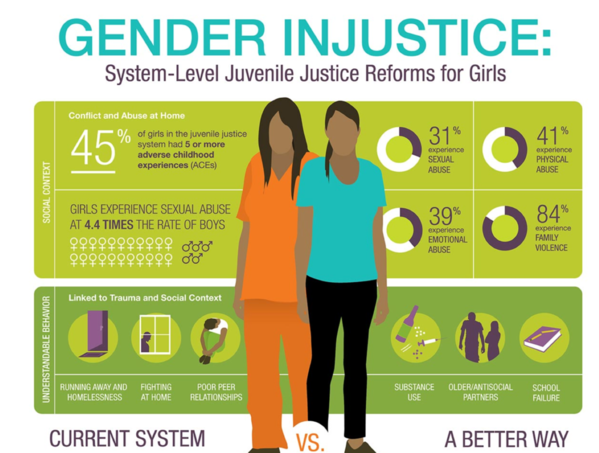
[This information is from The Crittenton Foundation website.]
Gender Injustice: System-Level Juvenile Justice Reforms for Girls by Francine T. Sherman and co-author Annie Balck. This report is the most comprehensive to date on girls in the juvenile justice system. The report is released through a partnership between The National Crittenton Foundation and The National Women’s Law Center and the authors.
The full report, executive summary and comprehensive infographic are here:
http://www.nationalcrittenton.org/gender-injustice/
A new ground-breaking and comprehensive report on girls in the juvenile justice system underscores deeply rooted, systemic gender injustice. The report’s troubling findings confirm that despite progress in juvenile justice, girls are locked up and left behind because of the lack of intentional focus on girls.
Girls are now making up a larger share of the juvenile justice population at every stage in the process, despite the overall decline in juvenile arrests in the last two decades:
- 45% increase in arrests
- 40% increase in court caseloads
- 40% increase in detention
- 44% increase in post-adjudication probation
- 42% increase in post-adjudication placement
- Girls experience violence and abuse in their homes and communities in greater concentrations than boys. They are then re-traumatized and criminalized by the current system.
- Girls are disproportionately arrested, formally processed, detained, and incarcerated in the juvenile justice system for offenses that pose little or no threat to public safety.
- Current juvenile justice system responses, especially incarceration, are particularly harmful to girls in the juvenile justice system because they are struggling to heal from trauma triggered by the violence and abuse they have previously experienced.
- This, most comprehensive report to date, concludes that:
- In the current justice system, girls’ coping behaviors, which are reactions to the violence and abuse they experienced, are criminalized rather than addressed and resolved.
- Girls are referred to juvenile justice due to failures in other public systems such as the child welfare, mental health and education systems.
- The increase in domestic violence related arrests of girls is due to changes in law enforcement policies (mandatory/pro-arrest laws) stemming from the Violence Against Women Act (VAWA) that are unintentionally harming instead of helping girls.
- Girls who are pregnant or parenting, have run away, or are victims of sex trafficking, are particularly misunderstood and mistreated by the system.
- Gender inequities fall heaviest on girls of color and LBQ/GNCT (lesbian, bisexual, questioning/gender-non-conforming, transgender) girls.
- Black girls are three times as likely as white girls to be referred to juvenile court.
- American Indian/Alaska Native girls are 50% more likely to be detained than white girls.
- In one study, 41% of LBQ/GNCT girls were detained or incarcerated for status offenses and 8% were detained or incarcerated for sexual exploitation, compared with 35% and 3.5 % of their straight or gender-confirming peers, respectively.
- Current large-scale juvenile justice reforms are leaving girls on the sidelines, and this is a missed opportunity to offer girls effective solutions and a healthy path forward.
- To ensure fair and effective treatment of girls, juvenile justice reforms must help and heal, not harm girls.
Recommendations call for states to:
- Stop criminalizing girls’ behavior that is clearly linked to trauma such as status offenses, prostitution, many school-based offenses, running away, and domestic battery.
- Immediately eliminate the VCO (Valid Court Order) exception from the Juvenile Justice and Delinquency Prevention Act (JJDPA).
- Revise mandatory/pro-arrest domestic violence laws.
- End the detention and incarceration of girls by closing secure institutions for girls.
- Invest in and enact trauma-informed, developmentally appropriate and evidence-informed approaches.


Comments (0)